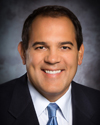By Raouf (Ron) Gharbo, DO
Paradoxically, healthcare burnout has become rampant in healthcare experts. Currently, the burnout literature is full of terms like compassion fatigue, moral injury and subjective surveys. The root causes are unremitting risk, conflict and pressure, leading to exhaustion, and we need an objective physiology-based model. I am a clinical investigator on several studies led by the University of South Carolina School of Public Health, and I present orientation CME to new providers with Riverside Health System on performance and decision making.
The logarithmic growth of heart rate variability (HRV) literature reveals these parameters are the established, most sensitive, all-cause mortality biomarker, marker of fatigue, cardiovascular health, predictive of sepsis outcomes, cancer outcomes at any stage and even predictive of long-term diabetic complications prior to the diagnosis of diabetes. HRV software can display anxiety and frustration graphically in real time to increase personal insights into hyperarousal emotional (limbic) decision making and decision fatigue factors. The military already assesses pre-deployment HRV data to predict future PTSD.
In addition to the HRV biomarkers, HRV biofeedback breathing skills are the only objective method to induce cardiorespiratory synchronization to physiologically reduce the emotional hyperarousal state; these could be the objective backbone to meditative and spiritual practices that have proven, healthy outcomes. Recently, studies have demonstrated that HRV breathing skills improve decision making under duress by shifting to a more energy-efficient state. One of our randomized control trials is showing that with a handful of training sessions, this skill attainment has persistence for several months.
Faced with daily conflict, many physicians and nurses choose a second major factor in performance: depersonalization. A lack of empathy has been widely shown to have poor performance outcomes, even poor surgical outcomes. I’ve learned from clinical experience during the opioid crisis that there are two basic physician-patient relationships during the rehabilitation process burdened by chronic pain. Patients typically present as transactional customers or engaged partners. The necessary paradigm shift is understanding that the patients and circumstances determine the type of relationship, not the provider. If uncertain, or if I need to assess future risk behavior, I can objectively, even remotely, measure engagement with an HRV breathing prescription of 10 minutes BID & PRN. I am committed to listen, understand and genuinely articulate empathy (cognitively) with all patients, but in difficult situations these HRV skills can allow a provider to physiologically de-fuel needless hyperarousal that can be draining. This skill empowers providers to be more judicious with triggering of their own cardiovascular system and HPA axis. Some examples include after a code blue or computer lockup, during or before hand washing, and during or after an intense interaction. Currently, consumer-wearable devices are unreliable, but medical-grade tools with intuitive platforms, coupled with value-based payment models, are inevitable. I developed a Stop, Shift & Decide method: stop the racing brain and shift emotion objectively on demand to improve decision making in line with your purpose and values. Both HRV wearables and HRV biofeedback will become ubiquitous, so start getting familiar – the Medical-Wearable Age is coming.
 Dr. Gharbo is a clinical investigator on several HRV studies, led by the University of South Carolina School of Public Health and funded by the VA. He provides monthly CME to orient new providers with Riverside Health System, and he is an adviser for Peerbridge Health.
Dr. Gharbo is a clinical investigator on several HRV studies, led by the University of South Carolina School of Public Health and funded by the VA. He provides monthly CME to orient new providers with Riverside Health System, and he is an adviser for Peerbridge Health.

